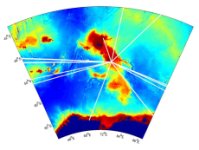|
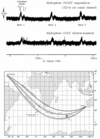
In 1960 explosive shots off Perth, Australia were detected at Bermuda about 20,000 km away. The precise path the acoustic pulses need to take to get to Bermuda is complicated, but acoustic modes 1 and 2 appear to have unobstructed paths from source to receiver. This figure is from the book "Ocean Acoustic Tomography" by Munk, Worcester and Wunsch (1995), after Heaney, Kuperman, and McDonald (1991).
|

One of the many people to take an interest in HIFT was Jacques Cousteau. In a visit to CSIRO Division of Oceanography in Hobart, Tasmania, Andrew Forbes had the opportunity to explain the principle of acoustic thermometry to him. Cousteau listened intently and asked some excellent questions, evidence of a keen interest in ocean science. Notable was his response to one of the accompanying reporters who asked, "Monsieur Cousteau, if this experiment manages to measure ocean climate change, what can we do to mitigate of reverse it?" Cousteau answered simply, "We are too many - we must control ze growth of ze population".
|
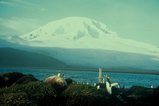
Heard Island is home to several seal species, predominantly Antarctic fur seals, but also Leopard and Elephant seals. Peguins complete the picture. Towering over the island is Big Ben, an active volcano with a permanent icecap and a smaller recently-formed Mawson's Peak. It is Australia's highest mountain, a fact known to few Australians, due to its remote, inaccessible location.
|
|
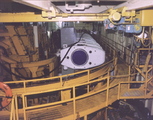
The array of 10 acoustic sources was lowered below the ship to make the transmissions. No more than five acoustic sources at a time were used, however.
|
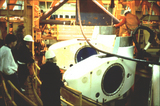
Two of the ten acoustic sources used for HIFT are shown in this figure. The Cory Chouest was equipped with complex mechanical racking and handling system for deploying the sources.
|

Many hours were required for each deployment and retrieval of the sources, primarily because of the time-consuming manual task of attaching massive fairings, segment by segment (as shown in Figure 4) to the supporting umbilical cable. Once the string of sources was deployed it was difficult to recover quickly, so the weather played a large part in determining the success of the experiment. Initially the weather behaved and the sources performed admirably. Several receiving stations reported solid receptions. However, as the seas grew larger, one by one the sources failed in the extremely heavy conditions, but not before all signal types had been thoroughly exercised.
|
|
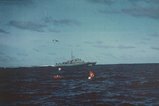
Temporary receivers for HIFT designed by APL/UW were shipped to several remote parts of the globe. These were essentially Sonobuoys, ruggedised and equipped with a larger battery to extend their life to a week or more. One of these was deployed by the Royal Australian Navy in the Indian Ocean near Christmas Island. The RAN routinely patrols the region between Indonesia and the Australian North Coast to detect and intercept illegal fishing and curtail people smuggling activities. For the duration of HIFT, the RAN accommodated a CSIRO scientist on board a Fremantle class patrol boat board, who operated the receiver and data logger according to the planned transmission schedule. The figure shows a HIFT receiver in the foreground (orange floatation collar) and a white recovery float to ease retrieval.
|
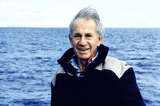
Walter Munk during the Heard Island Feasibility Test 1991.
|

The Walter Munk Award by the Office of Naval Research and the Oceanography Society features the Heard Island Feasibility Test on its medal. The acoustic pulses start at the back of the award and continue around to the front and both coasts of the United States.
|
